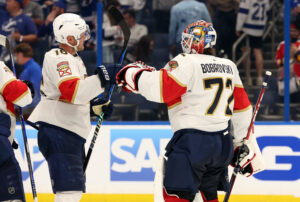When it was announced Micheal Ferland had returned to Manitoba, fans of his had a familiar sinking feeling. Though the blanket tern “unfit to play” was used by the NHL, different sources have been more specific. Ferland’s concussion issues have, so to speak, reared their ugly head.
A Roll of the Dice
The Vancouver Canucks were Ferland’s chosen destination after an off-season courted by different teams. Ten days after he reached free agency, they reached a deal. While he only officially had two concussions prior (in 2014 and 2018), they were a shadow hanging over the deal. Concussion symptoms are wildly unpredictable, and not a lot is known about how long their effects last. Hockey is a very physically demanding, high-impact game, even if players aren’t fighters.
For the Canucks it was worth pursuing a physical player who had played in the top-six for different teams. The team had been soundly criticized for not protecting Elias Pettersson, and different deals brought in Ferland and J.T. Miller to bring more ‘bite’ to the forward lines. In the previous two years, Ferland reached the 40-point mark with both the Carolina Hurricanes and Calgary Flames.
For Ferland, there are obvious reasons to sign a new deal. At $14 million over four years, he was more than willing to test his health playing a game he loved. Even if he didn’t make the full four years, the $2 million signing bonus helped.
Snake Eyes
Unfortunately for both Ferland and the Canucks, he was placed on injured reserve in November. He missed the entire month, returning briefly in December for two games before going back on the injured reserve list. This time, he rested for months, staying away from the game until February. He missed enough time that he went to Utica just to get back onto the ice in a game situation, compared to skating on his own.
It didn’t go well.
His one period return to professional hockey highlights just how difficult it is to diagnose when “healthy” is. Once again, Ferland was out of the game. This time, he had an unlikely ally in his attempted recovery: COVID-19. Sports teams and practice facilities alike shut down across North America. The closures gave Ferland no choice but to rest completely, no matter how good he felt or how eager he was to return. It was five months before training camps opened to re-start the league. By the time July came around, he was feeling as good as he ever had.
The Canucks wanted the player, he wanted to play. But they approached each other warily, starting him with the Black Aces squad. He did well enough there that promotion was quick. Soon he had earned a spot in the starting lineup against the Minnesota Wild. As if to prove he could handle whatever was needed, he dropped the gloves with Marcus Foligno on his first shift. Ferland played a total of 11:41 that game, with the Canucks losing 3-0.
Two days later, he would play just 2:36 in the rematch, not appearing at all for Game Three.
Ball of Confusion
For now, Micheal Ferland has left “The Bubble” in Edmonton and returned to his home in Manitoba. The official line is that he won’t be back for the Play-In round. Given he would need a four-day quarantine and as many days testing negative, it is unlikely he’ll return for the first round, either. And that’s in the best of circumstances, assuming he recovered fully, stayed in shape, and passed whatever test was needed. It’s hard to imagine any observer would be happy to receive him
But what does a team do if he did? What if, after all his tribulations, Ferland came knocking at the door and said he felt fine? The team could have their doctors look him over, and he can get his own doctor reports, and then…? To look at it through a mercenary lens, the team wants him to play, but not if they can’t rely on him to be healthy. They’d also like to have him play through all four years of their deal in the way they expect of him, not in a compromised form. In short, if he isn’t a physical player, what are they paying for? Ferland himself also wants to play out his contract. Not just for the money – though that’s a heck of a reason – but also because he sees himself as a hockey player. It’s what he does to earn a living.
There is little that has been negotiated between teams and players specifically regarding concussion health. This isn’t terribly surprising, given the nebulous forms concussion diagnosis can take. A lot of it boils down to asking the patient how they feel. Ferland has been given a clean bill of health each time he’s tried a comeback this year. None of those comebacks lasted.
Precedent Set
In reality, it is unlikely that Micheal Ferland comes back for any of the playoffs, no matter how well the Canucks do. His last unwilling “break” was five months long, and it wasn’t enough to keep him healthy. Even if the next season doesn’t start until December, that’s even less time with one additional concussion in his history. How could anyone – Ferland, the Canucks, any medical experts they consult – say he’s cured? And if not cured, then healthy enough to resume play with little risk?
The Canucks do have some history with telling an injured player he wasn’t getting back onto the ice. When Manny Malhotra sustained a terrible eye injury on March 16, 2011, he was determined to return. Amazingly, he did in time for Vancouver’s Stanley Cup run, joining the team for the last six games of the Finals. He played a full season the next year but in a diminished capacity. His physical play was far from his previous form, and his scoring ability likewise decreased. He was often unprepared for taking hits or plays on his left side, and then-GM Mike Gillis expressed his concern for Malhotra’s health. That off-season he and was told by the team he wouldn’t be playing in 2012-13.
Malhotra made a deal with the team, saying that with a full Summer to work on it he could make a full comeback. Unfortunately, the experiment only lasted nine games, and he was put on the injured reserve list for the rest of the season. There was an offer of working with the team as a coach, but Malhotra decided he had more to give on the ice. He played professional hockey for three more years, including two in the NHL, before retiring.
Differences Abound
It is relatively easy to test vision or to see what damage has happened to an eye. No matter how much a player wants to pass an eye test, it comes down to if he can. Much harder is to see what’s happened to a brain – especially with something as relatively subtle as a concussion. If a player needs to convince someone he feels fine, he can simply say “I feel fine.” In hockey especially there are dozens of stories of players “toughing it out” and returning through injuries. This is double in the playoffs, where every year we hear what players went through without anyone knowing as their teams are eliminated.
Manny Malhotra had physical damage done to his eye and orbital bone, requiring surgery. In a game as physical as hockey, he was at greater risk because of that limited vision. It could even be argued that since his play had changed to take that risk into consideration, he wasn’t living up to his contract. It’s a brutal argument, but it could be made. He could obviously still play – he managed over 80 games since returning, after all. But he couldn’t play like he had when he signed his deal, and not through the expected attrition of age.
Micheal Ferland has lots of reasons to tell people he’s fine, even at the risk of his own health. He’s a hockey player in the highest league in the world. There’s a lot of pride in that fact, and it’s a huge part of his identity. He has a new contract that’s paying him millions of dollars – if he can earn it. And, most insidiously, the concussion feels like it goes away.
The Micheal Ferland Mind Field
This is the worst part of a concussion. Not only does the player want to feel better, they often do feel better. Research into the long-term effects of concussions is still in its nascence. Almost all of the work has been done in this century, and it’s tremendously difficult to do on a large scale. We do know the effects, or what we suspect are the effects, can stay with someone their entire lives.
But who, ultimately, can take responsibility for a player’s long-term health? Should it be up to the player to assume the risk? Should it be the team safeguarding players as much as they can by dint of being responsible for putting them in dangerous situations? Athletes are well paid for that risk, but is that sufficient? Leagues have acted to protect players and even fans by changing rules, equipment, and even arenas.
The NHL settled one lawsuit regarding former players and concussions in 2018. Another was launched in 2019. Whatever the Vancouver Canucks decide, it’s hard to believe that they are going to act unilaterally with Micheal Ferland.
But it’s also going to be hard to watch him step onto the ice again.
Main Photo:






